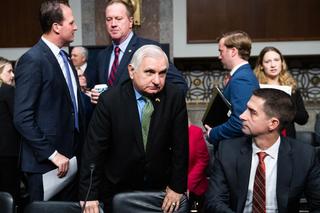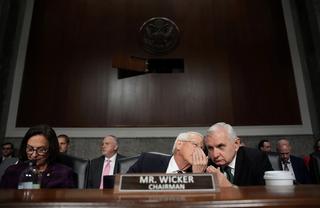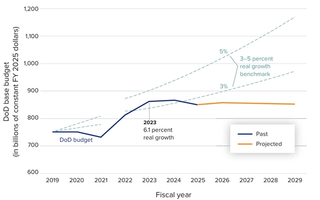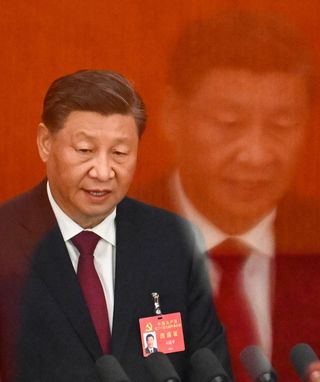The headlines
Donald Trump returned to office in January 2025 pledging to revitalise the US military, a theme consistent with his first term commitment to pursue a “great rebuilding of the Armed Forces.” Yet more than 100 days into Trump’s second term, it is clear that there are growing differences between his administration and Congressional Republicans over the budgetary requirements of ‘Peace Through Strength’. In theory, the White House and the Hill agree on the need for a ‘generational’ investment in national defence. Yet, while talking up a trillion-dollar defence budget, in practice the Trump administration has focused more on cutting or realigning Pentagon resources behind a slimmer set of strategic priorities to those favoured by Republican foreign policy traditionalists. Furthermore, it appears that Trump — like his predecessor — will rely on lawmakers to do the political heavy lifting on increasing defence spending, namely through a one-time funding boost through Republicans’ budget reconciliation efforts. This strategy is fraught with risk, considering that an increasingly polarised political environment in Congress, the ascendence of fiscal hawks in the Republican caucus, and downward budgetary pressures arising from inflation, national debt, and now tariffs have prevented members from boosting Pentagon spending in recent years.

The Trump administration’s adoption of the phrase ‘Peace Through Strength’ initially suggested that it would pursue a military modernisation and revitalisation program on par with President Ronald Reagan’s significant defence spending increases in the 1980s. Yet the administration has offered mixed signals on whether this will entail greater defence spending, while also promising to eliminate “hundreds of billions of dollars of fraud and abuse” from Pentagon programs. President Trump himself has voiced support both for increasing and decreasing the defence budget, calling for a trillion dollar defence budget on the one hand while suggesting that the United States could halve defence spending if an agreement could be reached with China and Russia.
What is happening behind the headlines?
Initial trends indicate that defence spending in Trump’s second term may end up mirroring his first: an initial boost followed by a return to flat growth.
The Trump administration’s FY26 defence budget request offers the strongest evidence that a higher defence budget is far from a done deal.
The Trump administration’s early actions suggest that ‘Peace through Strength’ will pivot on structural reform, program cuts and a recalibration of US national strategic priorities as much as — if not more than — new spending commitments. Following pledges in February to cut up to 8% of the Pentagon’s civilian workforce, in April 2025, Defence Secretary Hegseth issued internal guidance to “strategically restructure” the department’s workforce through offering fully funded resignations or early retirements to the Pentagon’s entire workforce, while also dramatically cutting senior officer numbers.
The Trump administration’s FY26 defence budget request offers the strongest evidence that a higher defence budget is far from a done deal. On paper, the administration has proposed to increase defence spending by 13% to an unprecedented US$1.01 trillion. Yet, White House budget documents suggest that it will request only US$892.6 billion in base discretionary defence spending, essentially keeping the Pentagon’s overall budget flat against Biden-era spending and constituting a cut when adjusted for inflation. Instead, the Trump administration will rely on Congress to bridge the gap through allocating an extra US$113-119 billion during the appropriations process, to be drawn from the US$150 billion boost proposed for defence between FY25 and FY29 as part of Republicans’ overall budget reconciliation package.
This approach has attracted significant pushback from senior Republicans. The chairs of both the House and Senate Armed Services Committees — both key Trump allies— along with prominent Senate appropriators have decried the absence of real spending growth and criticised the administration for relying on ‘accounting gimmicks’ to meet US defence requirements. Such frank criticism is notable, given how rarely Congressional Republicans have been willing to criticise the administration throughout its second term.
Key debates around the issue
The FY26 defence budget request underscores growing differences within and between Congress and the administration over the aperture for US strategy, financing the president’s agenda and who should ultimately control government spending.
Disagreement on defence strategy
Firstly, defence budget issues are a microcosm for differences between the Trump administration and Republican defence hawks over the scope of US global strategy. For its part, the administration has signalled a narrowing of US global strategic priorities to focus on homeland defence and the Indo-Pacific, with senior Pentagon strategists like Elbridge Colby arguing for a “realistic strategy of prioritization focused on China” in the absence of the military resources to uphold multi-theatre commitments. Secretary Hegseth’s Interim National Defense Strategic Guidance echoes those sentiments, flagging a reorientation of US force structure and global posture to focus acutely on border security and high-end deterrence missions around Taiwan by “assum[ing] risk” in other theatres and emphasising what prominent MAGA intellectuals have referred to as “burden owning” by traditional allies.
Prominent Congressional Republicans have already challenged these adjustments. While echoing Trump’s calls for ‘generational’ investments in the US defence industrial base and for allies to step-up their contributions to collective defence, leading defence hawks argue these are necessary to sustain the current US suite of global security commitments. Senators Roger Wicker (R-MS) and Mitch McConnell (R-KY), for instance, argue that Washington should reembrace military primacy and must “win, not just manage” strategic competition with China and Russia, claiming that a wider global drawdown to prioritise the Indo-Pacific would create power vacuums elsewhere for China to exploit. Unsurprisingly, they and other hawks have sharply criticised the administration’s FY26 budget request as one that “does not reflect a realistic path” to meeting either traditionalist or Trumpian defence objectives. These disagreements will only become more pronounced as the administration begins to socialise its forthcoming National Defense Strategy (NDS) and when Congress eventually turns its attention to the FY26 defence budget debate later this year.

Congressional budget battles
Secondly, defence spending could be a casualty of broader battles over government spending. These dynamics are frustrating Republican efforts to craft a reconciliation budget package which would help to fund the Trump administration’s broader policy agenda, including on defence. Though passing the measure into law requires only a simple majority, Republicans have struggled to unify around an agenda acceptable to the party’s various factions, with the Trump-aligned House Freedom Caucus proving the most disruptive. Both the House and Senate Armed Services Committees have proposed a US$150 billion boost to defence spending through to FY29, a plan which in isolation enjoys broad party and limited Democratic support. Yet significant intra-Republican party disagreements over cuts to non-defence spending both within and between the House and the Senate threaten to derail the broader reconciliation process, with House fiscal hawks demanding funding reductions and policy riders that are non-starters for many centrist Republicans – let alone Democrats – in both chambers.
These factors will also affect future budget deliberations. Many Republicans and Democrats have already signalled their opposition to White House proposals to cut 22.5% from non-defence domestic programs in its FY26 budget blueprint, yet the fiscally conservative House Freedom Caucus has embraced the blueprint as a “paradigm shift” and “a bold step toward fiscal responsibility.” Unlike the reconciliation process, Republicans will almost certainly require Democratic support to pass regular government-wide appropriations for FY26, unlikely to be forthcoming without greater parity between defence and non-defence spending.
The Trump administration’s decision to pass responsibility for increasing defence spending onto Congress is reminiscent of the high-risk and ultimately flawed approach assumed by the Biden administration.
It is for those reasons that prominent analysts are already worried that ongoing intra-party and inter-party disputes could see another full-year continuing resolution (CR) passed for FY26, marking three years of flat funding and further reducing the Pentagon’s purchasing power. These same experts, along with prominent Congressional figures, have also predicted a “net zero” defence budget environment for the foreseeable future, pointing to anticipated major funding shortfalls stemming from the entry of Trump’s tax cuts into law (presuming that they pass), economic blow-back from ‘Liberation Day’ tariffs, and higher inflation as major handbrakes on growing the Pentagon budget. In that broader context, the Trump administration’s decision to pass responsibility for increasing defence spending onto Congress is reminiscent of the high-risk and ultimately flawed approach assumed by the Biden administration. Indeed, budget caps negotiated between then-House Speaker Kevin McCarthy and President Joe Biden as part of the 2023 Fiscal Responsibility Act (FRA) prevented Republican defence hawks from securing funding increases above the FY24 and FY25 budget requests as they had done in FY22 and FY23.
Power of the purse
Finally, there are growing differences between Congress and the Trump administration over who should control government spending, including for defence. The president and other senior officials have explicitly questioned Congress’ traditional “power of the purse,” arguing that the executive should ultimately determine the distribution of government money. To that end, the administration has sought to rescind government funding appropriated under previous budget resolutions, and has also threatened to freeze future funding through “impoundment” if deemed unessential to implementing Trump’s agenda. These views are, naturally, directly at odds with those of Congress. Democrats have accused the administration of withholding nearly US$450 billion in government funding, including for key foreign policy accounts, while even close Trump allies are among a growing chorus of Republicans beginning to voice frustration with the administration’s attempts to dictate budget terms.
This raises the prospect that the president could refuse to spend Pentagon appropriations if he does not believe they align with his administration’s overall defence strategy, or in order to achieve geopolitical ends as Trump attempted to do with Ukraine during his first term. Indeed, these risks are already real with respect to FY25 defence appropriations. Defence budget experts have argued that Congress “ceded a significant degree of authority” to the White House in negotiating the first-ever full-year CR for the FY25 defence budget, suggesting that the absence of a legally binding appropriations bill that clarifies how money should be spent will give the administration much more power over how to distribute Pentagon dollars, notwithstanding explanatory letters submitted by appropriators after the fact. The unprecedented nature of these developments and the growing risks of another full-year CR in FY26 suggest that the administration’s newfound control over defence appropriations could endure, calling into question the role of Congressional appropriators in shaping US defence spending and, ultimately, strategy.
The implications
As one prominent news outlet put it, “uncertainty is the only constant in the Pentagon’s budget outlook.” While the administration and Congressional Republicans agree on raising defence spending, they evidently disagree on how to do it, with deepening fiscal and political fault lines likely to continue to afflict efforts to match US defence budgeting and strategy into the 2026 midterm elections.
What evidence is available at this early stage suggests that examining the first Trump administration’s approach to defence spending could yet prove instructive for the next four years. Though it secured major increases in FY17 and FY18, the first Trump administration ultimately fell short of its own objective of achieving 3-5% real increases annually in defence spending while in office. At the time, that trajectory was framed by senior military and civilian leaders as essential to meeting the objectives of the 2018 NDS, including — in the words of then-Secretary of Defense Jim Mattis — bringing America “back to a position of primacy.” Those requirements were recently echoed by the Congressionally-mandated Commission on the NDS, which argued in its June 2024 report that “real [spending] growth… within the range recommended by the 2018 NDS Commission” was required to implement the Biden administration’s own 2022 NDS.
Figure 1. NDS Commission budget increase bracket

Source: United States Congress
Evidence to date suggests that the second Trump administration could follow a similar pattern. Even if the administration’s gamble on lawmakers to plus-up the FY26 defence budget by nearly US$120 billion pays off, that would leave only US$31 billion in further reconciliation funding to bolster Pentagon spending out to FY29, well short of what both Republican hawks — and Biden’s Defense Secretary, Lloyd Austin— believe is required. It is also questionable whether a dramatic one-time increase in FY26 would be politically sustainable given the administration’s preoccupation with minimising government spending, its apparent unwillingness to increase base Pentagon spending in FY26, and the likelihood that Democrats will regain control of at least one chamber of Congress in 2026 with concurrent demands for parity in non-defence spending accounts. Nor does the administration appear to regard military primacy or the traditional range of US global commitments as obtainable or even desirable objectives, meaning that it cannot be assumed that the forthcoming NDS will simply revive the 3-5% growth target of the 2018 document if Trump plans to pursue a much narrower set of global security objectives.
Rising inflation and growing operational costs will also increase the costs of strategic indiscipline.
On the other hand, it is also debatable whether the Trump administration can effectively pivot to a narrower set of strategic priorities on the basis of a one-time budget injection and structural reform alone. Indeed, experts have already highlighted the structural limitations of the Pentagon’s reprogramming agenda, given that the exemption of some 17 capability categories — including unmanned systems, the submarine industrial base, missile production, operational readiness, and others — from Secretary Hegseth’s reprogramming guidance leaves few budget categories or capability programs available for substantial reprioritisation. Meanwhile, rising inflation and growing operational costs will also increase the costs of strategic indiscipline. For instance, despite being disavowed as a strategic priority, the surge in US military deployments to the Middle East since Trump took office in January 2025 will only prolong the additional pressures placed on US military readiness and industrial capacity which, more so than security commitments in Europe or support for Ukraine, have jeopardised like requirements in Asia.
What should allies like Australia do about it?
Realistically, there is little that Australia can do to influence broader budget dynamics to which, so far, defence spending debates have been largely secondary considerations. To the extent that their equities are engaged, America’s allies should focus on underscoring the value of initiatives at the intersection of regional force posture and defence industrial integration to the administration’s goals of rebuilding the foundations of American military power and preserving a favourable balance of power in Asia. Indeed, Secretary Hegseth's initial regional engagements have exhibited a high degree of continuity with the Biden administration in their focus on advancing bilateral and minilateral initiatives intended to foster "an integrated defense industrial base" between the US and its allies and partners in Asia.
To that end, Australia and other allies should redouble their engagements with key stakeholders in Congress and the administration. Considering that the primary sources of political lethargy and downward pressure on resourcing American regional strategy emanate from the House, Australia should focus its efforts on engaging with House Appropriations, Armed Services and Foreign Affairs Committees, where political disagreements over America’s role in the world have become particularly pronounced. In addition, given the high rates of attrition of key career and political positions at the Departments of Commerce, Defense and State since Trump took office, Australia and other allies should also redouble their engagements with acting and/or incoming figures from the Deputy Assistant Secretary level down to ensure that their equities are well-understood by a new generation of interlocutors across the new administration.
Unpacking trump 2.0









